
 |
|
Southwest Native Americans
As the world awakens in the crisp morning sunlight at dawn, a new day begins on the 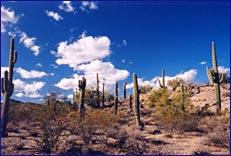 cedar covered mesas of northern Arizona and on the bright thirsty southern Arizona
deserts. At first glance, one might consider the dry arid landscapes of the southwest
United States and northern Mexico a barren desert wasteland.
cedar covered mesas of northern Arizona and on the bright thirsty southern Arizona
deserts. At first glance, one might consider the dry arid landscapes of the southwest
United States and northern Mexico a barren desert wasteland.
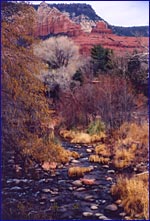 Yet, there are people who
have eked out a living on this dry expanse. Their cultures have grown up around their
farming techniques and their reverence for the land. The beauty of this land, with its
golden red canyons, monument valleys, and beautiful saguaro forests is unparalleled. This
beauty shows up in the crafts and artistry produced throughout the region. Today the
southwest holds the largest number of indigenous people in North America who still occupy
their original homelands and retain their ancient customs, beliefs, languages,
and traditions.
Yet, there are people who
have eked out a living on this dry expanse. Their cultures have grown up around their
farming techniques and their reverence for the land. The beauty of this land, with its
golden red canyons, monument valleys, and beautiful saguaro forests is unparalleled. This
beauty shows up in the crafts and artistry produced throughout the region. Today the
southwest holds the largest number of indigenous people in North America who still occupy
their original homelands and retain their ancient customs, beliefs, languages,
and traditions.
Navajo Nation The largest group of people in this area is certainly the Navajo, or, as they prefer to be called, DinÚ, meaning "The People". Occupying land in the Four Corners area of Arizona, New Mexico, Utah, and Colorado, the Navajo Nation is the largest and fastest growing tribe in the United States. The Navajo reservation is approximate in size to the state of West Virginia. The Navajo language is part of the larger Athabascan family. The Athabascan Indians populated parts of western Canada and Alaska, and today the Athabascans are an Alaskan tribe. As evidence of their migration across the Bering Strait some 13,000 years ago, the language structure and the look of the Navajo people are similar to the people of Mongolia. They moved south from Canada into the American southwest some 700 years ago, arriving shortly before the Spanish, and invading the areas occupied by the village dwelling Pueblo people. Archeologists now believe, based on lines of evidence such as bone form, molecular genetics, and linguistics, that the Athabascan Indians represent a second migration of people from Asia, while the existing Pueblo people descend from a previous migration some 3,000 years prior. Navajo society is a matrilineal one. Descent and membership in one of about sixty clans are traced through women. Navajo introduce themselves and establish relationships with other Navajo by naming their clans, and much of their behavior is determined by their clan affiliation. Much of Navajo culture and tradition is passed down through the clan using teaching methods such as storytelling. The traditional Navajo dwelling is a hogan (pronounced ho'gńn'), a hexagonal or octagonal house with a dome shaped roof built of logs and earth (According to Navajo creation beliefs, the original hogan had 5 sides). The entrance of the hogan always faces the rising sun, and upon entering, one always moves in a clockwise manner to get from the men's side on the south to the women's side on the north. Today the hogan still represents a symbol of the Navajo relationship with the land, and hogans are still seen dotting the reservation. Indeed, even modern homes are sometimes built incorporating the polygonal shape of the hogan, and every family must have a hogan for ceremonies, even if they live in a newer home. Navajo history in the southwest has often been stormy and tumultuous. After being brutally subdued by the Spanish in the 1770's the Navajo were subjected to a long and bitter period of slave trading, territorial encroachment, and bloody defeats where families were often captured or killed. Americans started moving into the area in the 1840's, and the Navajo hoped they would receive help in overcoming the Mexicans and freeing the Navajo slaves, as promised in the treaties. But the Americans not only did not help the Navajo, they were often instrumental in allowing slave raiding to continue. They invaded Navajo land, killing people and destroying crops. Relations were dismal, and when General James H. Carleton took command at Fort Defiance, he hatched a scheme that resulted in the "Long Walk", a march of 8,000 Navajo 300 miles to Bosque Redondo, a desolate land east of Santa Fe where they were imprisoned for six years. One quarter of the Navajo there died of starvation or illness. Those left behind, mostly the elderly, were hunted down and slaughtered by Kit Carson. The "Long Walk" is bitterly remembered by Navajo to this day. The Navajo have always been a pragmatic and progressive people who quickly assimilated some of the ways of the people around them. They picked up sheepherding, horsemanship, weaving, pottery making, and silversmithing from the Spanish or Pueblo people. Although they were culturally and linguistically very different, they also learned to cultivate corn, beans, and squash from the Pueblo people. Pueblo Tribes Today the Pueblo tribes are predominantly in the Rio Grande River valley area of New Mexico, but include the Hopi people, who are centered inside the Navajo reservation in northeastern Arizona. These Pueblo tribes descend from the ancient Anasazi, who settled in the southwest as much as 1,500 years ago, and possibly from the Mogollon people of southern Arizona and northern Mexico. Archeological digs have uncovered much information about the Anasazi and Mogollon. The Mogollon and early Anasazi lived in communities of sunken pit-houses, a partially underground and thermally efficient form of house well adapted for the extreme summer and winter temperatures that they experienced. 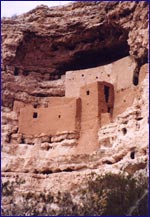 Later the Anasazi lived in cliff dwellings and
apartment-like pueblos on the mesas and canyons in the Four Corners area. They miraculously
coaxed corn, beans, and melons from the desert, and their dry farming techniques were passed
down to the present day Pueblo people.
Later the Anasazi lived in cliff dwellings and
apartment-like pueblos on the mesas and canyons in the Four Corners area. They miraculously
coaxed corn, beans, and melons from the desert, and their dry farming techniques were passed
down to the present day Pueblo people.
The Pueblo groups, living in the compact towns of adobe or stone, got their name from the Spanish word "pueblo", meaning village or town. The Hopi pueblos were perched atop three mesas protruding from the Colorado plateau, known from east to west as First Mesa, Second Mesa, and Third Mesa. At least one of these villages, Old Oraibi on Third Mesa, has been occupied for almost 1,000 years. Although the Hopi villages and towns have spread out beyond the tops of these original mesas, the original villages are still inhabited by Hopi who follow the traditional Indian way of life. The Hopi, whose name means "Peaceful People", are deeply religious, and their spirituality is intertwined with all of life and all that they do. They believe they are the stewards of Mother Earth, and that they must care for the land and its resources. The Great Spirit gave the Hopi a path to follow and a duty to fulfill, and they must insure a cooperative relationship with the spirit world to insure harmony with nature. When this harmony is broken, due to such disrespectful actions as human weakness, lethargy, or arrogance, it leads to evils, disasters, and misfortunes. The Hopi appeal to Katsinum during their ceremonies and sacred dances to keep them on the right spiritual path. Katsinas, or Kachinas as they are sometimes called by non-Hopi people, are spiritual intermediaries between people and the Great Spirit. They are cloud people, the spiritual embodiment of Hopi ancestors, and they appear in human form at the various ceremonies between December and July. The Hopi are remarkable in their ability to tenaciously retain a distinct cultural identity, which has evolved from their strong religious beliefs and from centuries of insisting on traditional patterns of life. When the Spanish entered Hopi territory during the sixteenth century, the Hopi were forced to submit to the Spanish crown and to convert to Catholicism. The Spaniards forced the Hopi to close Kivas, their sacred underground ceremonial chambers, and prohibited the traditional ceremonies. In 1680, all of the Pueblo tribes banned together and plotted an insurrection against the Spanish, which drove them back into Mexico. During the Revolt of 1680, Catholic friars were executed and mission churches were destroyed. After the Revolt of 1680, the Catholic Church never re-established itself in Hopi territory. The Hopi still have a purer version of Pueblo life as it was handed down to them from their Anasazi and Mogollon ancestors. Although the normally pacifist Hopi participated in The Pueblo Revolt of 1680, it was the New Mexican Pueblos who bore the brunt of early and continued contact with the Spaniards. After 12 short years of independence from Spanish mistreatment, the Spanish returned to New Mexico and re-conquered the Pueblo tribes there. When the Spanish first arrived in the southwest in 1540, there were 85 pueblos in New Mexico. Today, only 19 survive. Despite the destructive power of the government and the church, of war and disease, and of change and growth, the Pueblo people have managed to survive with their native cultures intact. Today, the various pueblos are masters of the crafts that have been handed down from their ancestors and refined to produce the contemporary art for which they are becoming world renown. Although some of the crafts can be found at each pueblo, many are developing their own styles that are recognized and sought after. The Jemez Pueblo are famous for their Storyteller Pottery and the Friendship Pots. The San Ildefonso and Santa Clara Pueblos have become known for their beautiful black pottery created in an oxygen deprived reducing atmosphere, while the Acoma Pueblo produce beautiful thin-walled white clay pottery. The Zuni have become known for their animal fetishes and carvings, and the Santo Domingo for their beautiful jewelry of turquoise and inlaid stones. Other Tribes Besides the Navajo and the various Pueblo tribes, there are other Southwest Native American tribes of note living in the American southwest. These include the Tohona O'odham, Apache, Hualapai, Paiute, Ute, Cocopah, Cochiti, and Mojave. The Tohona O'odham, or Desert People, were previously known as the Papago Indians. Their reservation in southern Arizona is the second largest in the United States, and extends into Sonora, Mexico. It is approximately the size of the state of Connecticut. They had a unique agrarian society designed to take advantage of heavy flooding following the summer thundershowers in this desert country. The Apache, settling in east central Arizona and New Mexico, were a fierce warrior tribe who long maintained their hunting and gathering way of life. Like the Navajo, they also are descended from northern Athabascan tribes. The Apache in Arizona are mostly composed of five groups: the San Carlos Apache, the White Mountain Apache, the Cibecue Apache, the Tonto Apache, and the Yavapai Apache. The Apache in New Mexico includes the Jicarilla and Mescaleros tribes. Handicrafts The range and variety of art coming from the Native Americans of the American southwest reflects the rich and complex history of the area. From basketry to tightly woven rugs, from turquoise to pottery, many of the handicrafts have been passed down for generations from ancestors of long ago. Many today are preserving their past and their culture by adhering to the traditional practices taught to them. Carvings & Sculptures Southwest Native American Indians are masters at carvings, and some unique artistry comes from the different tribes. The carvings and sculptures are often a product of their religious beliefs. From the Zuni, we have carved Zuni fetishes. These are typically animal carvings, but we also have a carved Indian Maiden. (more on Zuni Fetishes...). The Hopi carve Katsina dolls, representing inhabitants of the spiritual realm who are the embodiment of Hopi ancestors. Although other Native American tribes have taken to carving Kachinas, the carving of Katsinam comes from Hopi spiritual beliefs, and only the Hopi Katsinam are authentic representations of the ceremonial Katsinam. Navajo Sand Paintings Navajo sand paintings are often used in healing and religious ceremonies. Sand paintings are sometimes used to relate folklore stories. The paintings are very detailed and colorful, and each figure carries a special meaning. The most common figures in sand paintings are Ye'is, or Navajo holy people. Another frequently used design is the four sacred plants which are corn, beans, squash, and tobacco. Other designs may be animals, plants, rainbows, lightening, or bows and arrows. The Navajo believe that the creator placed them on the land between four sacred mountains, representing the four cardinal directions. These mountains encompass major parts of traditional Navajo religious beliefs, helping them to live in harmony with both nature and their creator. The artistic sand paintings carried by Global Tradewinds display incomplete symbols or are created in such a way that show no disrespect to the Navajo beliefs. They are created as unique objects of art (more on Navajo Sand Paintings...). Pottery and Ceramics Southwest Native Americans have been making pottery for thousands of years. Pottery reflects the culture of its maker. The Pueblo tribes of New Mexico each have their specialty, and some of the traditional and contemporary pottery coming out of this area is first rate artistry. Traditional pottery construction is done by the coil and scrape method. Long ropes of clay are coiled into the desired shape and pinched together, and then the vessel is scraped smooth. The surface is often polished using a smooth polishing stone, and fired, usually in an outdoors fire. Some of the pottery, such as the black pottery of Santa Clara and San Ildelonso, must be completely covered during the firing process to prevent oxygen from reaching the piece, resulting in the black color. Firing in an open fire can result in "fire clouds" on a piece, which is an irregular discoloration resulting from burning fuel coming into contact with the vessel. Fire clouds are often sought as proof that the pot has been fired outside, and not in a kiln. Certain pots, such as the white Acoma pottery, are often fired in a kiln to maintain the bright white color. Navajo Rugs 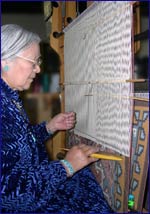 When making the beautiful Navajo rugs, traditional Navajo weavers often raise and shear the
sheep, and wash, card, spin, and dye the wool themselves. Many of the weavers die the wool with
their own naturally grown vegetables, or using native plants such as wild walnut or lichen. The
time spent preparing the wool can exceed the time spent weaving. Weaving a large rug can take
some two thousand hours to complete. Unlike the weavers of South America and Mexico, who
use horizontal looms, the Navajo weave their rugs on home made vertical looms, where the
warp threads are continuously looped in a figure eight around two horizontal bars. This allows
constant control over the tension of the warp, resulting in a strong smooth foundation for
a tightly woven rug with finished edges, adding to the beauty and durability.
When making the beautiful Navajo rugs, traditional Navajo weavers often raise and shear the
sheep, and wash, card, spin, and dye the wool themselves. Many of the weavers die the wool with
their own naturally grown vegetables, or using native plants such as wild walnut or lichen. The
time spent preparing the wool can exceed the time spent weaving. Weaving a large rug can take
some two thousand hours to complete. Unlike the weavers of South America and Mexico, who
use horizontal looms, the Navajo weave their rugs on home made vertical looms, where the
warp threads are continuously looped in a figure eight around two horizontal bars. This allows
constant control over the tension of the warp, resulting in a strong smooth foundation for
a tightly woven rug with finished edges, adding to the beauty and durability.
The styles and designs of the rugs are regional, with some of the designs, such as Ganado, Two Grey Hills, and Burntwater, being recognized by their color alone. Others, such as Chinle, Teec Nos Pos, and Eyedazzler, are recognized by their distinct design. Each rug represents a unique piece of fine collectable art. Native American Jewelry Perhaps silverwork and turquoise jewelry are the best known of all Indian crafts. Today many of the artists work with a variety of metals and stones, including copper, coral, mother-of-pearl, and seashells. Techniques include beadwork, stones inlaid in metal (typically silver), and carving. Probably nothing reveals the artistry as much as a fine heishi strand. Heishi, an old Indian art passed down from the Cliff Dwellers, translates to "shell". Shells are carved into discs and the hole is then drilled in the center. It takes a highly skilled artisan to drill and align the discs into the beautiful and flexible strand. Heishi is the oldest form of jewelry in New Mexico, and perhaps in North America, pre-dating the introduction of metals Native American Musical Instruments The sounds and music of a society can be one of their most defining characteristics. For the Native Americans, music was often accompanied by the drum, flute, or rattle. The drums of the Native Americans helped to keep the beat during their ceremonies and celebrations, and rattles help to insure the rhythm. Native American Dolls The Native Americans often gave dolls to their children as a way of teaching them the ways and traditions of the culture. Global Tradewinds' Navajo dolls are traditionally created by contemporary Navajo artists. Basketry When one thinks of weaving, it immediately conjures up images of Navajo textiles. But basketry is another important weaving art of the southwestern Native Americans, and is one of the oldest surviving crafts. Using local materials such as yucca and willow, the Native American baskets were used for utilitarian purposes such as carrying and storing grain, or for ceremonial purposes, such as the beautifully coiled Navajo Wedding Basket. The basket weaver must have a wide range of knowledge about the plants required for the baskets, and it is not unusual for the weaver to travel from 50 to 100 miles or more gathering the required plants. The plants must then be prepared by bleaching, soaking, stripping, and trimming, which can be as time consuming as the actual weaving. Although the prices of Native American baskets seem inflated, one comes to appreciate the baskets more when they realize the time and skill that is required. |
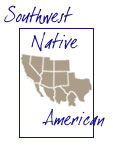
|
|||||||||||||||||||||||
Global Tradewinds Home
|
Customer Service
|
Contact Us
|
About Us © 2002-2008 Global Tradewinds, Inc. All rights reserved. |
|||||||||||||||||||||||||